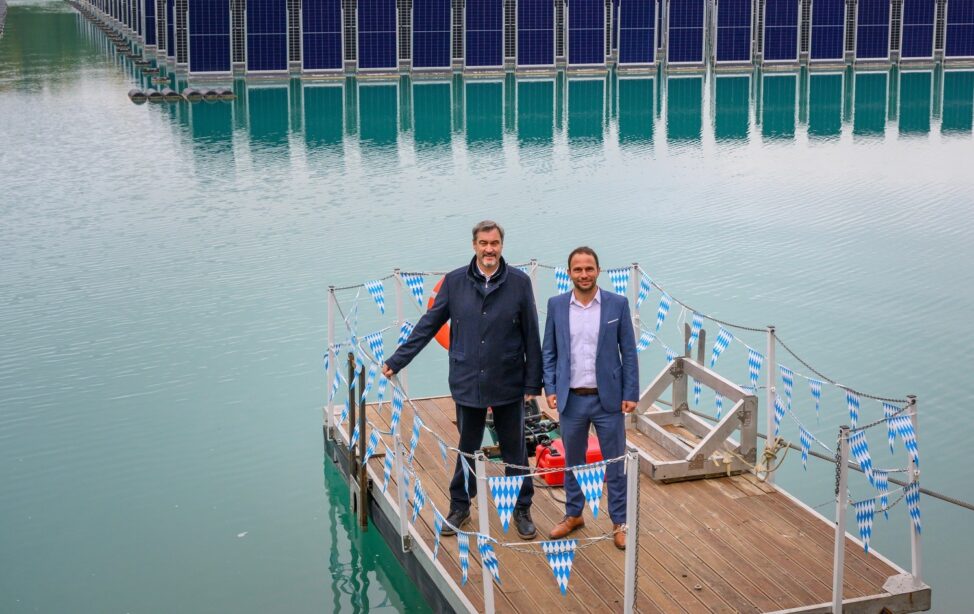
TUM Ambassador Jonathan Veinot is a professor in the Department of Chemistry at the University of Alberta in Canada and has been an enthusiastic fan of TUM for over ten years (Picture: Magdalena Jooß/TUM).
A GUEST YEAR AT TUM
But back to the beginning: Jonathan Veinot’s relationship with TUM began more than a decade ago with a big bang – specifically, a volcanic eruption. At that time, he was one of more than 120 scientists from 16 countries who met at the Evangelische Akademie Tutzing to discuss the latest developments in the field of colloidal nanoparticles. On the last day of the conference, the Eyjafjallajökull volcano in Iceland erupted, and air traffic in much of Northern and Central Europe had to be suspended for several days. Jonathan Veinot was stranded. “And what does a silicon chemist do when he’s stuck?” he asks, laughing as he gives the answer himself: “He goes out and looks for other silicon chemists.”
Jonathan Veinot knew that a renowned expert in this field was working at TUM. So he knocked on the door of TUM Professor Bernhard Rieger from the WACKER Chair of Macromolecular Chemistry. “I was lucky that he didn’t throw me out right away, as I appeared unannounced,” says Jonathan Veinot. But the two professors immediately hit it off, stayed in touch, inviting each other to conferences, and two years later, Jonathan Veinot came to TUM as a guest researcher for a research year with Professor Rieger.
When we think about the future of our discipline, our young talents will make the difference.
ESTABLISHING TRUST AMONG SCIENTISTS
Throughout his scientific career, Jonathan Veinot has collaborated with colleagues from all over the world. “There is no question that one of my most rewarding experiences was my stay in Germany at TUM. I believe the reason for this is that we were able to spend a lot of time together in person. This made it easy for us to build personal trust and friendships,” he says.
Jonathan Veinot wanted to share this enriching experience with his students, and thus the idea for a doctoral exchange program was born. The vision: an international graduate school where doctoral students in Germany and Canada could visit each other and work together on hybrid materials, polymers, and nanomaterials. Bernhard Rieger and Jonathan Veinot wrote emails, made phone calls, knocked on doors, and eventually brought together nine TUM and eight UofA professors from the fields of physics, engineering, and chemistry who were willing to engage in the program.
A HOME FOR CURIOSITY
Jonathan Veinot is a chemist through and through. From an early age, he was fascinated by the smell of gasoline and the rainbow-colored shimmer of oil on water. Today, he is motivated by his fascination with nanoparticles, which are so small that they have size dependent properties that can revolutionize many aspects of our everyday lives. “Curiosity and fascination always need a place where they can grow and universities play a central role in helping this happen,” he says.
Creating and fostering places of scientific exchange is an important concern for the chemist. “In this sense, I also take my role as a TUM Ambassador very seriously,” says Jonathan Veinot. He received the award in December 2015 from the president of TUM. Each year, international guest scientists who have enriched TUM with their scientific expertise and international experience during their stay are honored in this way. TUM Ambassadors are links between TUM and the international academic research and industrial community.
Jonathan Veinot takes this mission very seriously and promotes TUM in Canada whenever the opportunity arises. “TUM calls itself the ‘entrepreneurial university.’ And entrepreneurship is about seizing opportunities when they arise,” summarizes Jonathan Veinot. “After the volcanic eruption, I took the initiative, and this wonderful collaboration emerged as a result. That’s why I always tell my students and doctoral candidates: Seize the opportunity to spend time at TUM. For me, it was a life and career changing opportunity that began more than ten years ago.”

TUM Ambassador Jonathan Veinot (Picture: Magdalena Jooß/TUM).
TUM Ambassador 2015
Prof. Dr. Jonathan Veinot is a professor in the Department of Chemistry and Associate Dean STEM Research in the College of Natural and Applied Sciences at the University of Alberta in Canada. He grew up in southern Ontario and earned his Ph.D. at York University in Toronto. In 2012, he came to Germany to TUM and conducted research at the WACKER Chair of Macromolecular Chemistry with Professor Bernhard Rieger. In the same year, he was invited to an OECD expert meeting in Berlin as an expert on the environmental impact of nanomaterials. The honorary title of TUM Ambassador was awarded to him in 2015 by the former president of TUM, Wolfgang A. Herrmann.
To this day, his scientific and friendly connections to TUM remain strong. He continues to lead the Alberta/Technical University of Munich Graduate School for Functional Hybrid Materials (ATUMS). For his impressive contributions in the field of silicon nanomaterials, he was awarded the Burghausen Chemistry Prize by the chemical industry of Bavaria in 2016. A year later, he received the Award for Excellence in Materials Chemistry from the Canadian Chemical Society.



